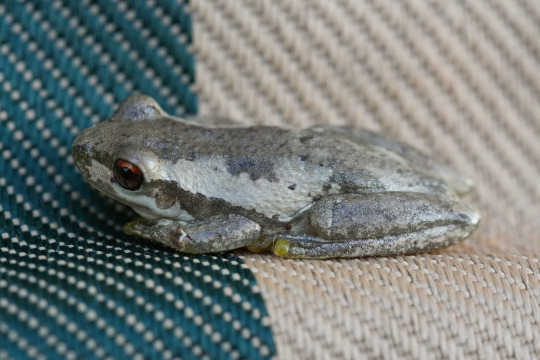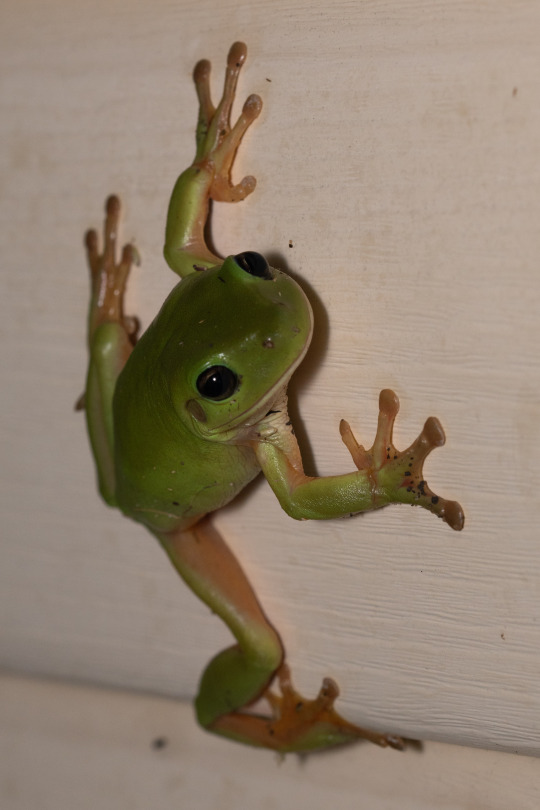#litoria latopalmata
Explore tagged Tumblr posts
Text
Many Beautiful Frogs and Frog Songs of Bellthorpe Frog Camp! We made lots and lots of recordings for FrogID too!
#great barred frog#mixophyes fasciolatus#slender bleating frog#Litoria balatus#eastern dwarf tree frog#Litoria fallax#striped marsh frog#limnodynastes peronii#Pearson’s stream frog#Litoria pearsoniana#Red-eyed tree frog#Litoria chloris#Tusked frog#Adelotus brevis#Striped rocket frog#Litoria nasuta#broad-palmed rocket frog#Litoria latopalmata#eastern stony creek frog#Litoria wilcoxii#peron’s tree frog#Litoria peronii#frogs#animals#amphibians#video#animal video#frog camp#australian frogs
217 notes
·
View notes
Text
thought I would share some of the incredible amphibian diversity we see in our garden. all of these creatures are from the same genus of treefrogs, Litoria (excepting Green Tree frogs, which are also often described as genus Ranoidea).

a Broad-palmed Rocket Frog (Litoria latopalmata), who we have spotted in the bog cave the past few nights! this species has proven to be highly variable in colour and patterning, so always interesting to encounter.

the pebble-shaped Desert Tree Frog (Litoria rubella), who hunt insects on my car in multitudes.

one of my favourites, the Peron's Laughing Tree Frog (Litoria peronii). at a distance they appear a uniform beige, but a closer look reveals flecks of emerald green across textured skin. this species tends to be a bit larger than the other frogs, but is still dwarfed by the Green Tree Frog.

a Slender Bleating Tree Frog (Litoria balatus), who I have posted before. one of the smallest of the frogs we see, but nonetheless intriguing with their yellow toes, and vibrant red eye.

last, and largest, is the conspicuous Green Tree Frog (Litoria/Ranoidea caerulea), a species found across much of the continent, and frequently found around human dwellings.
that's 5 species of tree frog all found within our relatively small garden, which is pretty amazing. we've also recently encountered a pair of Striped Marsh Frogs (Lymnodynastes sp.) around the pond (hopefully I can get a good photo soon), and of course there are the ever-present Cane Toads (Rhinella marina).
#ljsbugblog#bugblr#not a bug#macro#amphibians#litoria#treefrogs#tree frogs#litoria latopalmata#broad-palmed rocket frog#litoria rubella#desert tree frog#litoria peronii#peron's laughing tree frog#litoria balatus#slender bleating tree frog#litoria caerulea#ranoidea caerulea#green tree frog#australian green tree frog
32 notes
·
View notes
Text
Goin’ froggin’ proves a popular pastime
Each week Cosmos takes a look at projects and news about citizen science in Australia. This week, we talk to FrogID chief scientist Jodi Rowley, who is curator of amphibian and reptile conservation biology at the Australian Museum, Sydney.
Last week the Australian Museum (AM) reported a remarkable piece of news: its citizen science FrogID program surpassed 200,000 validated frog records. That makes FrogID – launched in November 2017 – one of the country’s most successful citizen science projects.
The 200,000th record came with a recording from southern Sydney of the threatened red-crowned toadlet (Pseudophryne australis). A citizen scientist named Tom recorded the call on the FrogID app. He’s one of more than 30,000 people across Australia who are currently registered with FrogID. The app’s been downloaded more than 150,000 times.
FrogID chief scientist Jodi Rowley. Credit: Photography by Stuart Humphreys
Spend some time talking to Jodi Rowley and you get the idea that such a level of interest is a jolly good thing.
“We don’t yet understand how many species of frog we actually have in Australia,” she says. “We don’t know where they’re distributed and really how they’re doing. We’ve already lost at least four species of frog and there are about 36 that are that are listed as threatened. And that’s out of 240 native species.”
FrogID grew out of this big knowledge gap in Australia – that and the fact, as Rowley says, that “there’s not that many frog biologists [in Australia], and Australia is really big”.
The program’s origin is a conversation Rowley had with Australian Museum director Kim McKay. “I was telling her how every species of frog has a different call,” says Rowley. “And she said, ‘what we need then is a frog Shazam’. I could never have dreamed that I would be part of the creation of a national citizen science project. That’s just beyond me as a scientist, but with the weight of the museum and Kim behind it, this project actually got going.”
“Frog Shazam” isn’t a bad descriptor for FrogID. As Rowley says, every frog species makes a different sound, and by recording your local frog calls on the app you can both learn about which species live nearby and contribute to the pool of national data. All you need is a smartphone and the app.
“It is like a field guide, but it’s one that we update all the time,” says Rowley. “The project has been going on for three years, we now have this amazing information, and we’re extending the maps of frog distributions all the time. There’s the case of a guy that was a bore runner in the NT, going out and checking the water level for the cattle tanks. He would hear frogs and make recordings, and he made a 100 kilometre range extension for a frog.”
Reliance on recordings of frog calls is perhaps the main benefit of FrogID. There are significant disease transfer issues with frogs – for instance around the deadly chytrid fungus – and researchers really don’t want people to disturb them, especially by handling them, or their habitat.
“I certainly encourage people to take photos if they see a frog,” say Rowley. “But something like 7% of all photos show someone holding a frog with their bare hands, and you don’t really want them touching one frog and then another because that can really negative conservation implications.”
Broad-palmed frog (Litoria latopalmata). Credit: FrogID
That makes FrogID’s ease of use really attractive. You don’t need to know what species of frog you’re recording. You don’t even need to know if it is a frog. “We get a lot of recordings of insects and that’s fine, because [people] learn what is an insect and what is a frog,” says Rowley. “So FrogID is great in that you don’t need to know – you just press record for 20 to 60 seconds and submit.”
Logged calls go through a series of steps, including review by sound-analysis software, to be indentified, but the human factor is critical. “I validate all of the calls, but we have experts in different states who are most familiar with frogs in their state,” says Rowley. “If there’s any uncertainty [the recordings] often go to all of us – so that we’re really confident. And that’s especially true when there’s like a chorus of 11 species calling from western Queensland!”
The growing pool of data helps Rowley and her co-researchers identify where frogs are thriving and where they aren’t, and to learn more about how different frog species are responding to changing climate and environments. Understandably, Rowley would like to see FrogID keep going for as long as possible.
“In order to understand any kind of impact of environmental change, particularly climate change, you really do need something for at least 10 years,” she says. “I would really hope that this project could go for 10 years or more because it’s changing the face of frog conservation. And citizen science is changing the face of conservation in general.”
Goin’ froggin’ proves a popular pastime published first on https://triviaqaweb.weebly.com/
0 notes
Text



an incredibly white Broad-palmed Frog chilling in our bog. colours can range from dark copper to tan and grey, but this was the brightest individual we'd seen yet!
Broad-palmed Frog (Litoria latopalmata).
#ljsbugblog#bugblr#entomology#macro#not a bug#amphibia#amphibians#frogs#pelodryadidae#australasian tree frogs#litoria#litoria latopalmata#broad-palmed frog
17 notes
·
View notes
Text




Some more New Frog Friends from the Bellthorpe Frog Camp! The Striped Rocket Frog (Litoria nasuta), the Broad-palmed Rocket Frog (Litoria latopalmata), and the Eastern Stony Creek Frog (Litoria wilcoxii), male and female!
#frogs#animals#amphibians#frog camp#striped rocket frog#broad-palmed rocket frog#eastern stony creek frog
119 notes
·
View notes